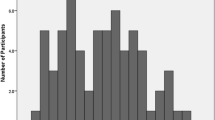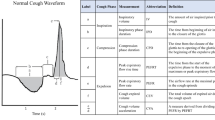Abstract
Background
Disordered swallowing, or dysphagia, is almost always present to some degree in people with Parkinson’s disease (PD), either causing aspiration or greatly increasing the risk for aspiration during swallowing. This likely contributes to aspiration pneumonia, a leading cause of death in this patient population. Effective airway protection is dependent upon multiple behaviors, including cough and swallowing. Single voluntary cough function is disordered in people with PD and dysphagia. However, the appropriate response to aspirate material is more than one cough, or sequential cough. The goal of this study was to examine voluntary sequential coughing in people with PD, with and without dysphagia.
Methods
Forty adults diagnosed with idiopathic PD produced two trials of sequential voluntary cough. The cough airflows were obtained using pneumotachograph and facemask and subsequently digitized and recorded. All participants received a modified barium swallow study as part of their clinical care, and the worst penetration–aspiration score observed was used to determine whether the patient had dysphagia.
Results
There were significant differences in the compression phase duration, peak expiratory flow rates, and amount of air expired of the sequential cough produced by participants with and without dysphagia.
Conclusions
The presence of dysphagia in people with PD is associated with disordered cough function. Sequential cough, which is important in removing aspirate material from large- and smaller-diameter airways, is also impaired in people with PD and dysphagia compared with those without dysphagia. There may be common neuroanatomical substrates for cough and swallowing impairment in PD leading to the co-occurrence of these dysfunctions.



Similar content being viewed by others
References
Smith Hammond CA, Goldstein LB, Zajac DJ, Gray L, Davenport PW, Bolser DC (2001) Assessment of aspiration risk in stroke patients with quantification of voluntary cough. Neurology 56:502–506
Pitts T, Bolser D, Rosenbek J, Troche M, Sapienza C (2008) Voluntary cough production and swallow dysfunction in Parkinson’s disease. Dysphagia 23:297–301
Ebihara S, Saito H, Kanda A, Nakajoh M, Takahashi H, Arai H, Sasaki H (2003) Impaired efficacy of cough in patients with Parkinson disease. Chest 124:1009–1015
Dicpinigaitis PV, Alva RV (2005) Safety of capsaicin cough challenge testing. Chest 128(1):196–202
Knudson RJ, Mead J, Knudson DE (1974) Contribution of airway collapse to supramaximal expiratory flows. J Appl Physiol 36(6):653–667
Hegland KW, Troche MS, Davenport PW (2013) Cough expired volume and airflow rates during sequential induced cough. Front Physiol 4:167
Vovk A, Bolser DC, Hey JA, Danzig M, Vickroy T, Berry R, Martin AD, Davenport PW (2007) Capsaicin exposure elicits complex airway defensive motor patterns in normal humans in a concentration-dependent manner. Pulm Pharmacol Ther 20:423–432
Smith JA, Aliverti A, Quaranta M, McGuinness K, Kelsall A, Earis J, Calverley PM (2012) Chest wall dynamics during voluntary and induced cough in healthy volunteers. J Physiol 590(Pt 3):563–574
Harris RS, Lawson TV (1968) The relative mechanical effectiveness and efficiency of successive voluntary coughs in healthy young adults. Clin Sci 34(3):569–577
Abbruzzese G, Berardelli A (2003) Sensorimotor integration in movement disorders. Mov Disord 18(3):231–240
Sapir S, Ramig L, Fox C (2008) Speech and swallowing disorders in Parkinson disease. Curr Opin Otolaryngol Head Neck Surg 16(3):205–210
Hughes AJ, Daniel SE, Kilford L, Lees AJ (1992) Accuracy of clinical diagnosis of idiopathic Parkinson’s disease: a clinico-pathological study of 100 cases. J Neurol Neurosurg Psychiatr 55(3):181–184
Rosenbek JC, Robbins JA, Roecker EB, Coyle JL, Wood JL (1996) A penetration-aspiration scale. Dysphagia 11:93–98
Gross RD, Steinhauer KM, Zajac DJ, Weissler MC (2006) Direct measurement of subglottic air pressure while swallowing. Laryngoscope 116:753–761
Macklem PT (1974) Physiology of cough. Ann Otolaryngol 83:761–768
Leden Von, Isshiki N (1965) An analysis of cough at the level of the larynx. Arch Otolaryngol 81:616–625
Mahajan RP, Singh P, Murty GE, Aitkenhead AR (1994) Relationship between expired lung volume, peak flow rate and peak velocity time during a voluntary cough manoeuvre. Br J Anaesth 72(3):298–301
Leow LP, Beckert L, Anderson T, Huckabee ML (2011) Changes in chemosensitivity and mechanosensitivity in aging and Parkinson’s disease. Dysphagia 27(1):106–114
Lasserson D, Mills K, Arunachalam R, Polkey M, Moxham J, Kalra L (2006) Differences in motor activation of voluntary and reflex cough in humans. Thorax 61(8):699–705
Lee SC, Kang SW, Kim MT, Kim YK, Chang WH, Im SH (2013) Correlation between voluntary cough and laryngeal cough reflex flows in patients with traumatic brain injury. Arch Phys Med Rehabil 94(8):1580–1583
Ward K, Seymour J, Steier J, Jolley C, Polkey M, Kalra L, Moxham J (2010) Acute ischaemic hemispheric stroke is associated with impairment of reflex in addition to voluntary cough. Eur Respir J 36(6):1383–1390
Hovestadt A, Bogaard JM, Meerwaldt JD, van der Meche FG, Stigt J (1989) Pulmonary function in Parkinson’s disease. J Neurol Neurosurg Psychiatr 52(3):329–333
Pitts T, Rose MJ, Mortensen AN, Poliacek I, Sapienza CM, Lindsey BG, Morris KF, Davenport PW, Bolser DC (2013) Coordination of cough and swallow: a meta-behavioral response to aspiration. Respir Physiol Neurobiol 189(3):543–551
Bolser DC, Gestreau C, Morris KF, Davenport PW, Pitts TE (2013) Central neural circuits for coordination of swallowing, breathing, and coughing: predictions from computational modeling and simulation. Otolaryngol Clin North Am 46(6):957–964
Davenport PW, Bolser DC, Morris KF (2011) Swallow remodeling of respiratory neural networks. Head Neck 33(Suppl 1):S8–S13
Mazzone SB, Cole LJ, Ando A, Egan GF, Farrell MJ (2011) Investigation of the neural control of cough and cough suppression in humans using functional brain imaging. J Neurosci 31(8):2948–2958
Malandraki GA, Sutton BP, Perlman AL, Karampinos DC, Conway C (2009) Neural activation of swallowing and swallowing-related tasks in healthy young adults: an attempt to separate the components of deglutition. Hum Brain Mapp 30:3209–3226
Yamanda S, Ebihara S, Ebihara T, Yamasaki M, Asamura T, Asada M, Une K, Arai H (2008) Impaired urge-to-cough in elderly patients with aspiration pneumonia. Cough 4:11
Ruddy BH, Pitts TE, Lehman J, Spector B, Lewis V, Sapienza CM (2013) Improved voluntary cough immediately following office based vocal fold medialization injections. Laryngoscope. doi:10.1002/lary.24529
Inzelberg R, Peleg N, Nisipeanu P, Magadle R, Carasso RL, Weiner P (2005) Inspiratory muscle training and the perception of dyspnea in Parkinson’s disease. Can J Neurol Sci 32(2):213–217
Acknowledgments
Dr. Hegland’s work is supported in part by the American Heart Association and BAE defense systems. Dr. Okun serves as a consultant for the National Parkinson Foundation, and has received research grants from NIH, NPF, the Michael J. Fox Foundation, the Parkinson Alliance, Smallwood Foundation, the Bachmann-Strauss Foundation, the Tourette Syndrome Association, and the UF Foundation. Dr. Okun has previously received honoraria, but in the past >36 months has received no support from industry. Dr. Okun has received royalties for publications with Demos, Manson, Amazon, and Cambridge (movement disorders books). Dr. Okun is an associate editor for New England Journal of Medicine Journal Watch Neurology. Dr. Okun has participated in CME activities on movement disorders in the last 36 months sponsored by PeerView, Prime, and by Vanderbilt University. The institution and not Dr. Okun receives grants from Medtronic and ANS/St. Jude, and the PI has no financial interest in these grants. Dr. Okun has participated as a site PI and/or co-I for several NIH, foundation, and industry sponsored trials over the years but has not received honoraria. Dr. Troche’s work is supported in part by an NIH (NCATS) CTSA through the University of Florida (UL1TR000064 and KL2TR000065).
Conflict of interest
The authors declare that they have no conflict of interest.
Author information
Authors and Affiliations
Corresponding author
Rights and permissions
About this article
Cite this article
Hegland, K.W., Okun, M.S. & Troche, M.S. Sequential Voluntary Cough and Aspiration or Aspiration Risk in Parkinson’s Disease. Lung 192, 601–608 (2014). https://doi.org/10.1007/s00408-014-9584-7
Received:
Accepted:
Published:
Issue Date:
DOI: https://doi.org/10.1007/s00408-014-9584-7




